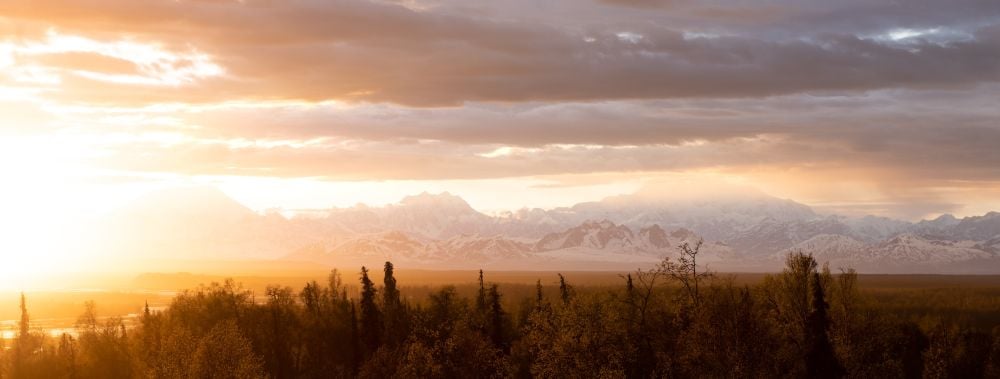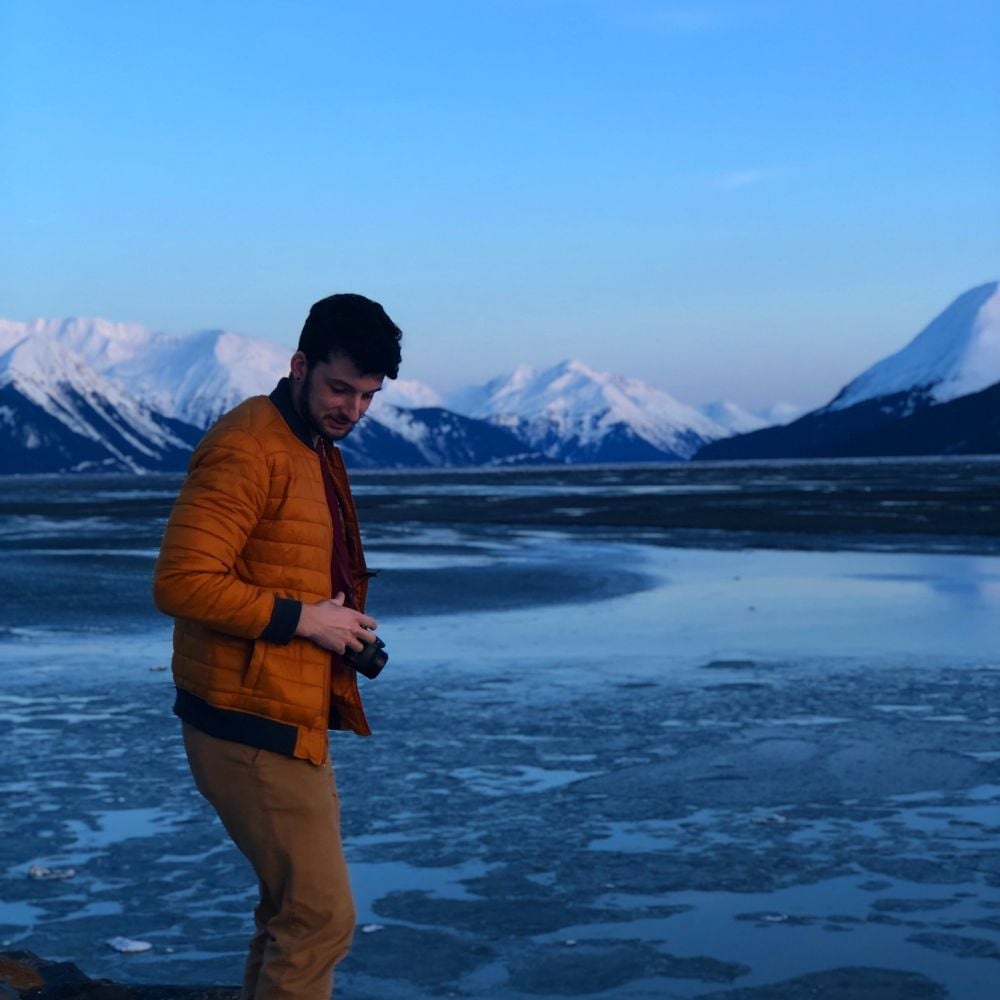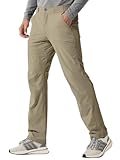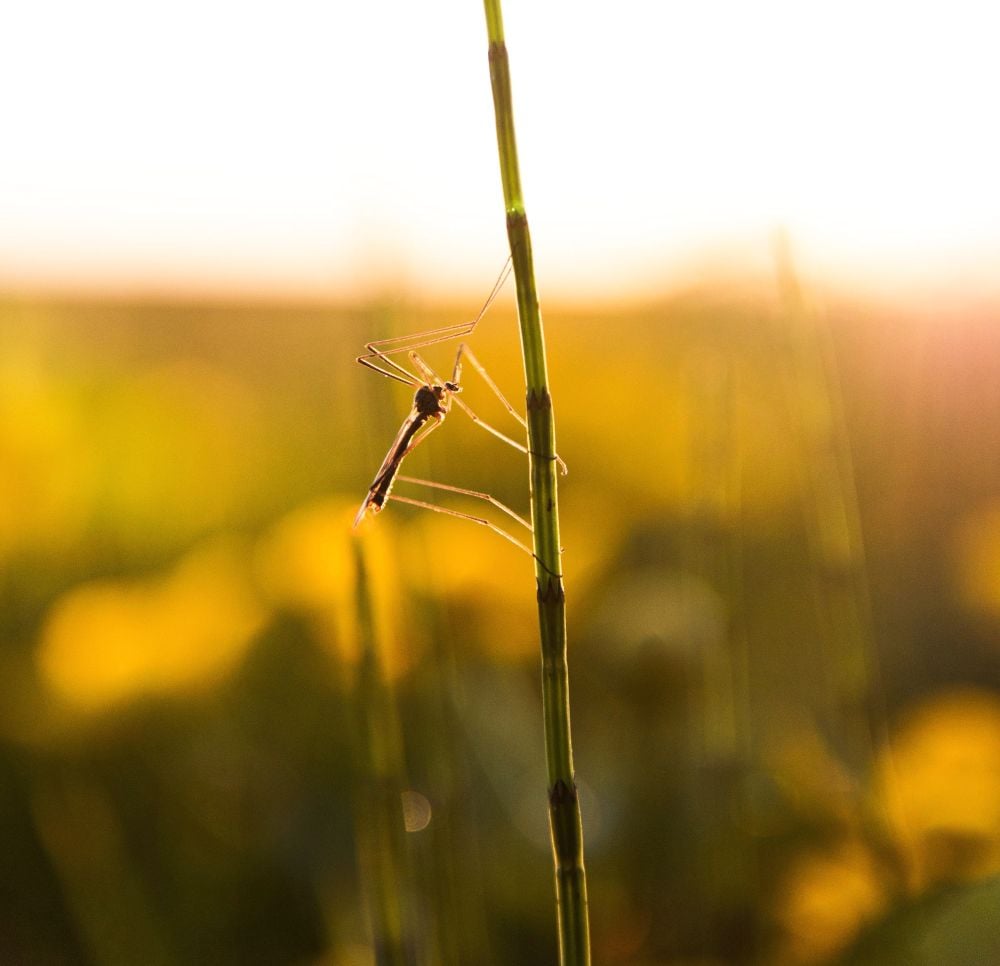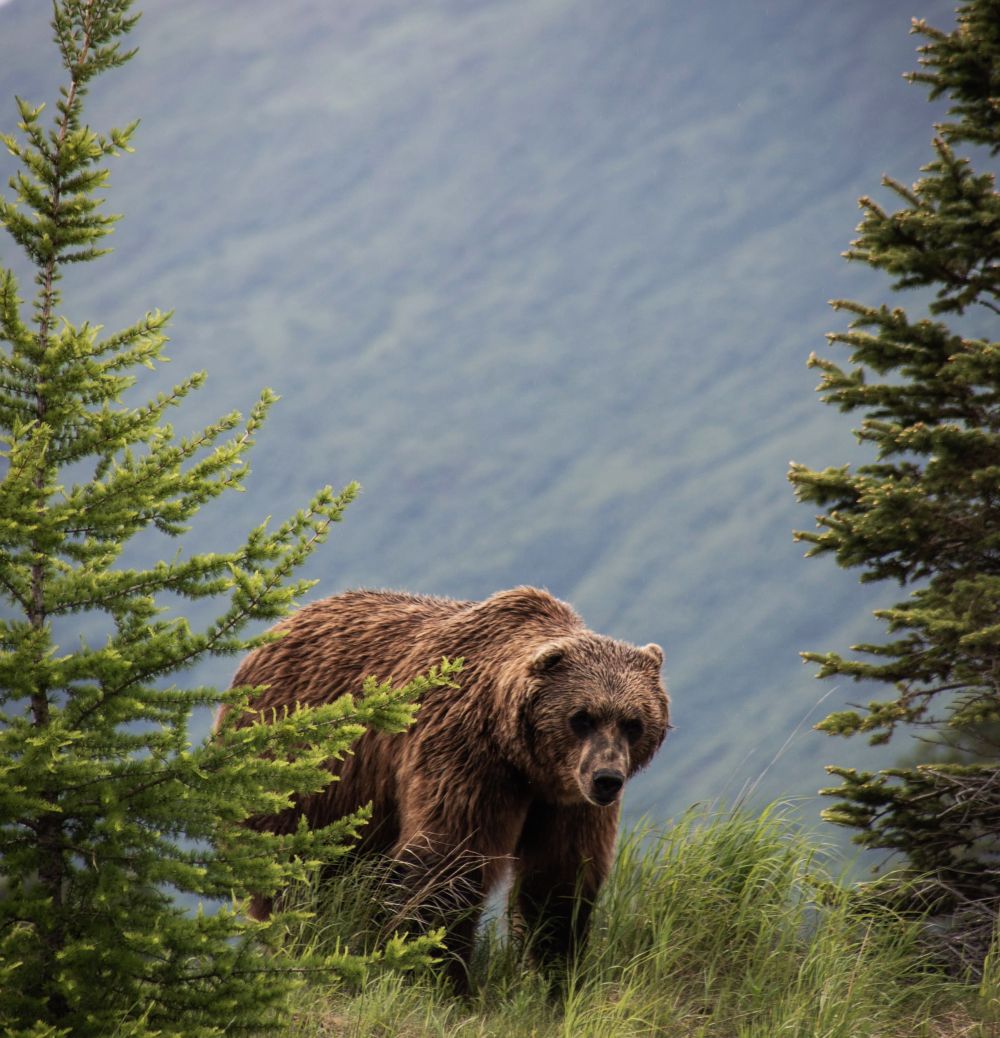September is considered autumn in Alaska. Foliage will have a lively rainbow of colors as the change from warmer to colder seasons occurs.
As a plus, prices will be cheaper and areas less crowded giving travelers more for their money and space to enjoy the extraordinary landscape.
On the other side of the coin, if traveling later in September, many activities and facilities won’t be available. Good preparation will provide visitors with an amazing vacation so they can become part of a special group of people that have experienced the Alaskan way of life.
Want to enjoy the best hotels and tours in Alaska without spending a fortune? You’re in luck! Below, you’ll find our hand-picked links to unbeatable deals on top-notch stays and exciting adventures — all within your budget:
🎟️ Best Alaska Tours | GetYourGuide
🛥️ Kenai Fjords Cruise | GetYourGuide
🛖 Book Cheap Hotels in Alaska | HOTELS.COM
More essential resources:
🛣️ Alaska Travel Guides (Amazon)
All of these links open in a new tab. They are incredibly useful for your Alaska trip in September.
💡 Provided by Alaska locals, we give you all the crucial tips you need for your trip in this article:
- September weather details with temperatures for each region
- What to wear and what to pack for this month
- How to get around in September
- Driving and road conditions
- What is still open and what is closed
- The best tours
Alaska Travel Guide | Essential for the September
‘Essential for your trip! We lived in Alaska for over 7 years, and we had the Milepost Planner in our car 100% of the time. No matter where you are or what you are looking for in Alaska, the Milepost will immediately orient you. If you don’t purchase it before going, you’ll find yourself buying one once you arrive in Alaska!’
- Peregrine, Paul (Author)
- Glacier, Sophia (Author)
9 Reasons Why September Is a Great Time

September is a very good time to visit Alaska. Especially, the first two weeks of the month are an excellent period, as most tourist destinations and facilities are still open and the weather is mostly pleasant with average high temperatures reaching 62°F (17°C).
- The temperatures are milder and the weather conditions are better than in winter.
- The summer crowds are gone after Labor Day weekend.
- Northern Lights viewing is already possible from late August or early September.
- Early September to mid-September is the peak time for amazing fall colors in many areas.
- It’s an excellent month to see the bears catching salmon in Katmai National Park (Brooks Falls)
- More locals travel in September so you have more chances to get in touch with them.
- It’s cheaper in terms of airfare and lodging compared to the summer months.
- Most stores, facilities, and restaurants are still open until September 15.
- The trains and motorcoaches operate regularly until mid-September.
Weather

The weather during September in Alaska can be sunny and up to 68°F (20°C) at the beginning of the month. In late September, it gets colder, and even snow is possible. The average high temperatures in the coastal and interior region range from 51°F (10°C) to 62°F (17°C). The daylight lasts about 13 to 14 hours.
Typical temperature progression in Anchorage | Average high temperatures:
- Early September: 62°F (17°C)
- Mid-September: 56°F (13°C)
- Late September: 51°F (10°C)
The temperature drops significantly during September. Thus, the first week of the month is the best time to travel for somewhat mild autumn weather. However, please keep in mind that the conditions are often erratic and that it gets a lot colder in the mornings or evenings. Anchorage, for example, has an average temperature of 39°F (4°C) in late September in the early morning.
Temperatures in the mornings and evenings:
- Arctic region:
Mornings: 33°F(1°C)
Evenings: 37°F(3°C) - Interior region:
Mornings: 41°F(5°C)
Evenings: 55°F(13°C) - Southern Coastal region:
Mornings: 53°F(12°C)
Evenings: 56°F(13°C)
Unpredictable Weather: September is a gamble, and the weather in Alaska is unpredictable during this time. Additionally, cloud cover and wind conditions affect daily temperatures in all regions. We experienced all sorts of during this month, from pleasant days to cold, harsh, and windy periods.
So, be prepared for anything and make sure to check our clothing and packing suggestions further below.
The temperatures and conditions vary across the three main regions of the state: Arctic, Interior, and Coastal. The northern region has the longest days and coolest climate.
Average high temperatures in September for different cities and regions:
- Anchorage: 59°F(15°C) – South Central
- Denali National Park: 57°F(14°C) – Interior
- Fairbanks: 62°F (17°C) – Interior
- Katmai National Park: 55°F(11°F) – Southern Peninsula
- Homer: 55°F(13°C) – Southern Kenai Peninsula
- Juneau: 57°F (14°C) – Southeast
- Seward/Kenai Fjords National Park: 59°F (15°C) – Southern Coastal
Daylight

During September, the daylight hours are quickly starting to fade. Civil Twilight is about one hour of time before sunrise and after sunset when the sun drops just below the horizon but there’s still enough light for activities. Daylight hours in September around the state are listed below:
- Fairbanks: 13 hours
- Anchorage: 13 hours
- Juneau: 13 hours
- Seward: 13 hours
- Nome: 13 hours
Rain and Snow
September is late shoulder season, basically a short fall, where Alaska is moving from summer into winter. Find the average amount of rainy days below:
- Arctic Fairbanks area – 11 days
- Southcentral Anchorage area – 14 days
- Inside Passage Juneau area – 20 days
- Southwest Kodiak/Aleutian Islands area – 16 days
Rain can be quick showers or all-day downpours during this month. Please check the weather forecast and be prepared for anything.
Snow is rare in September in Alaska but always remember anything is possible in this climate. In particular, it might snow anywhere in late September and even earlier in the upper mountainous elevations.
However, being the shoulder season, the snow season will be starting in the following months. For September, please find the average snowfall amounts below:
- Far North Barrow area – 1.5“/3.8cm
- Interior Alaska – Fairbanks area – 1”/2.5cm
- Southcentral Anchorage area – 0.0”/0.0cm cm
- Southeast Juneau area – 0.0”/0.0cm
- Southwest Kodiak area – 0.0”/0.0cm
Wind
The wind in Alaska depends upon the topography of a location as well as the weather conditions. Across the state, wind conditions vary greatly. Average wind speeds below:
- Aleutians Islands – 26 mph
- Denali – 20 mph
- Fairbanks – 18 mph
- Haines – 16 mph
- Nome – 16 mph
- Juneau – 13 mph
- Anchorage – 7 mph
Wind chill: Wind is making you feel colder than it actually is. Alaska has some really windy spots which we listed at the end of this article.
Cruise Weather / Day Cruises / Whale Watching
September is the last month of the cruise season in Alaska. It’s also the last month for many day cruises and whale watching tours. Most of them operate until mid-September.
Tip: September is a great month for whale watching as so many species can be spotted and the tours still run until around September 25. The 6-hour cruise from Seward (see the image above) is an amazing opportunity to see many whales in September.
Keep in mind that it’s colder on a boat. The temperatures are in the low to high forties on average. As the month progresses, the temperatures plummet, and the nights and early mornings can be exceptionally cold.
What to Wear/What to Pack
The temperatures are cooling down, so travelers need to prepare for more fall-like conditions. Layering clothes is essential from our experience, as the weather can change quickly and vary throughout the month.
In early September, you might still wear t-shirts in Alaska. Much thicker clothes are required towards the end of the month. Pack clothing items with moisture-wicking materials, water-resistant outer layers, and a winter coat for late September.
At higher elevations and during morning and evening hours, it will be cooler and some areas are windier which has an effect on the temperature. All of these areas and times require more layering.
For cruises/day cruises/tours: It’s colder on a boat. Wear thick pants, knit sweaters, and insulated shoes, as well as waterproof rain gear. A winter jacket is recommended.
Moisture-wicking fabrics such as nylon and spandex are easy to layer and excellent for these weather conditions. Waterproof/resistant clothing is essential for Alaska’s September climate and should always be the top layer.
Recommended pants:
Jackets: A fleece or nylon blend jacket with a hood or any waterproof/resistant jacket can be your outer (shell) layer. Even if your jacket has a hood, bringing a toboggan, scarf and waterproof/resistant gloves are important.
Recommended jackets:
How many jackets? We recommend packing one light/medium jacket and one thicker coat (see below). For early September two light/medium jackets.
For cooler days, especially in the second half of the month, wool/fleece sweaters and socks work well in layering and are very warm.
Do you need winter clothes/winter jackets? The suggested inner layers in combination with rain jackets are usually fine until mid-September. However, we advise packing a winter jacket for the second half of September, especially for late September. It gets cold in the morning and in particular if you go on a day cruise or stay outdoors for longer. Most locals recommend packing wool socks, mittens or gloves, and a hat for any time in September.
Recommended winter jackets for mid-September to late September:
Shoes: Insulated, durable waterproof/resistant shoes/boots with good sole traction will provide you with a comfortable and dry experience during any outdoor excursion in September. Our boot suggestions are Baffin or BOGS brands.
Clothing/Packing List:
- Nylon/Spandex shirts, shorts, pants/leggings – skin layer or top layer
- Wool/Fleece Sweaters – mid layer
- Waterproof/Resistant pants – outer layer
- Waterproof/Resistant coat with hood
- Waterproof ball cap
- Toboggan
- Scarf
- Waterproof/resistant gloves
- Merino wool socks or any warm moisture wicking socks
- Waterproof/Resistant shoes closed toed sandals, and or boots
*Cotton clothing is not preferable due to its ability to absorb moisture
Items to pack:
- Travel First Aid Kit
- Paracord Bracelet – If going to remote areas
- Sunglasses
- Sunblock
- Windproof umbrella
- Eye mask
- Portable charger
- Chapstick – Alaska’s climate is dry
- Lotion, moisturizing shampoo and conditioner
- Reusable Water Bottle – Tap water is ok to drink
- Binoculars (some tours may provide them as well)
- Cash – In some areas, vendors may not take credit/debit cards or digital payments
- Hand and Toe warmers for colder days
- Walking sticks for hiking
Crowds/How Busy Is It?

This is the last month of the year for a number of excursions in Alaska. The weather is cooling down as well as daylight fading. By mid-month, many activities have closed down.
September in Alaska isn’t as busy for travelers compared to the summer months. Crowds are significantly reduced within the first two weeks after Labor Day weekend and prices will be cheaper. The second half of the month allows an even quieter, less stressful trip.
Tips for even more solitude:
- If you aren’t cruising but want to visit a port town, you can avoid the crowds by traveling further inland to see the area. Most cruise passengers stay in close vicinity to the dock (2-3 blocks radius).
- If you are a cruise traveler and want to avoid the crowds at the port, venture further inland for sightseeing. Can go on foot, by taxi, or rent a car.
- To miss the crowds in early September (especially on Labor Day weekend) you can take the ferry on the Alaska Marine Highway System. This ferry takes you to smaller communities of Alaska’s inside passage like Wrangell St. Elias (Caveat: It can take between 3-6 hours to go from port to port).
- Visit Alaska regions that are less known such as Kodiak Island (must take a flight there), and Wrangell-St. Elias National Park and Preserve, book a remote outback hunting or fishing expedition as well as a guided hike and stay in a secluded B&B or wilderness lodge, and finally take a road trip on the Glenn Highway into the Copper River Basin or Richardson Highway between Valdez and Fairbanks.
Mosquitoes
September is a nice time to travel to Alaska if one wants to avoid mosquitoes. They peak in late June and early July. By the shoulder season in fall, they have died off.
Activities
To take part in all the summer activities that Alaska has to offer, traveling in the first two weeks of September is required. Towards the end of September, the winter activities will start taking place in the state, and many facilities shutting down. Snow is more likely to start in October, but if it does snow in September (called termination dust), it is likely to stick at higher elevations and in the northern areas.
Summer Activities (First Half of September):
- 4 Wheeling/ATV Tours –
- Glacier & Wildlife Cruises
- Gold Panning & Mining
- Hiking
- Biking
- Ziplining
- Glacier Hiking
- White Water Rafting
- Kayaking, Canoeing & SUP
- Railroad Tours
- Drive the Anton Anderson Memorial Tunnel to Whittier
- Summer Dog Sledding
- Wildlife Viewing
- Photography Tours
- Rafting & River Trips
- Flightseeing
- Fishing: Ocean and River
Flightseeing | Day Cruise | Arctic Circle
Alaska is just amazing in September. It’s the last month when you can enjoy all those fascinating tours, cruises, and flights. Keep in mind that some operate only until mid-September. Our favorite ones are:
- Talkeetna (between Anchorage and Denali): On a jaw-dropping plane flight you will experience glaciers, massive mountains, and the majesty of Denali itself. Visit Talkeetna when driving from Anchorage to Denali. Reservations: Talkeetna: Mountain Voyager with Optional Glacier Landing
- Seward: On an incredible day-cruise through the Kenai Fjords National Park, you’ll see whales, wildlife, mountains, and glaciers. Enjoy the incredible beauty of Alaska’s pristine waters. Reservations here: Seward: Kenai Fjords National Park 6-Hour Cruise
- Fairbanks: On this unique tour with excellent and super-friendly guides, you visit the spectacular Arctic Circle and walk through the breathtaking landscapes around Yukon River. Reservations here: Arctic Circle Adventure – Full-Day Tour
Reservations | Booking in Advance
Even in the shoulder season, it is strongly recommended to book in advance. This will reserve your spot and still give you time to cancel. Many tours and excursions can be booked a year in advance
💡 Anchorage ‘Budget’ Hotel Tip: If you are having trouble finding a great hotel for a reasonable price in Anchorage, we highly recommend the Aspen Suites Hotel Anchorage (via booking.com – save the hotel link if you like). The location is very convenient and it always meets all our expectations: a Super clean bathroom, comfortable bed, a very peaceful hotel, and everything for a reasonable price!
Travel agents suggest not to book any later than four months out from the travel date. Some tours can be booked on short notice, but we always recommend making reservations in advance
Reservation links (save money):
- Anchorage (via booking.com): More hotels in Anchorage. Sort by star rating & price
- Talkeetna – Hotel Deals: We recommend staying one night in Talkeetna when driving from Anchorage to Denali
- Denali National Park (we recommend Healy instead of the touristy Glitter Gulch)
- Fairbanks (via booking.com): Sort by star rating & price
- Seward (via booking.com): Sort by star rating & price
Tip: Bookmark the links if you want to browse for the best prices later.
Getting Around
- Car: Throughout September
- Motorcoach (Bus): Until mid-September
- Regular Train: Until mid-September
- Winter Train: From mid-September (only Anchorage <> Fairbanks)
Once you arrive in Anchorage via plane or in Seward via cruise ship, the best ways to travel in Alaska during September are by car, train, or motorcoach/bus. Each method has its own unique advantages.
A good idea is to combine train and motorcoach for example. By using the railroad on at least one route, you are able to view stunning scenic landscapes that can only be witnessed by train.
Tip: Most locals say, that the most picturesque landscape is the train route from Anchorage to Seward. The views are impressive on this 4-hour ride.
Driving is possible throughout the month and you can use the motorcoach and the regular trains until mid-September:
- Car: Renting a car is the best way if you want maximum flexibility. Since the roads are typically still clear of snow and accessible in September, you can drive to most places during this month. However, be careful when rainfall increases as the road can get slippery. Make your reservation for a rental car in Anchorage well in advance.
- Motorcoach (until mid-September): The Alaskan Park Connection Motorcoach is a very convenient way to get to and from Anchorage, Denali Park, Seward, Talkeetna, and Whittier. There are two daily departures from Anchorage to both Seward and Denali National Park. They stop operating in mid-September. Make sure to check the current schedule: Official Alaska Coach Park Connection Schedule
- Train (until mid-September): Experience Alaska by train is more expensive than the motorcoach, but a truly unique adventure. Trains are available to the major destinations: Anchorage, Talkeetna, Denali Park, Fairbanks, Whittier, and Seward. The train schedule typically runs until September 15-18. Check the schedule here: Official Alaska Railroad Schedule
- Winter Train (from mid-September): If you plan to visit in the second half of September you can still take the train. The Aurora Winter Trains runs throughout the winter until mid-May. However, it only operates on weekends and on selected dates mid-week. This train connects Anchorage and Fairbanks. Check the schedule here: Alaska Railroad – Aurora Winter Train
Tip: If you visit Alaska via cruise ship and arrive in Seward or Whittier, you can make use of the many transfer options offered by Alaska Train & Motorcoach.
Estimated Travel Times
Anchorage to Seward:
- Car: 2.5 hours
- Motorcoach: 3 hours
- Train: 4 hours
Anchorage to Denali:
- Car: 4.5 hours
- Motorcoach: 5 hours
- Train: 8 hours
Denali to Fairbanks:
- Car: 2.5 hours
- Motorcoach: 3 hours
- Train: 4 hours
Northern Lights
This is the time of year when the daylight has subsided enough to be able to view the phenomenon of the Northern Lights. Starting in fall, throughout the winter, any Alaskan travelers have the chance to experience this beautiful array of colors. In September, you will have higher chances to see the lights if you venture into the areas below:
- Interior: Denali and Fairbanks
- Northern part: Arctic Circle and Coldfoot
Driving/Road Conditions
The roads in September should still be in good shape but with the rainfall increasing, drivers need to be cautious of slippery conditions. When you plan to venture into the mountains it’s advised to use an AWD/4WD and equip the car with all-weather or studded tires. Even though it’s the end of the summer season, you need to always be aware of constantly changing weather and road conditions.
Unmaintained highways over the winter:
- Denali Park Road
- Denali Highway
- Taylor Highway: Runs from the Alaska Highway to Eagle, Alaska – Only open during the summer and partially paved
- McCarthy Road: – Wrangell-St. Elias National Park – Open year round – Unpaved
Highways open and maintained over the winter:
- Dalton Highway: Fairbanks to Deadhorse near the Arctic Ocean – Partially paved
- Seward Highway: Anchorage to Seward – Completely paved
- Alaska Highway: Southeast Alaska to British Columbia, Canada – Completely paved
- Glenn Highway: Connects Anchorage and the Alaska Highway – Completely paved
When renting vehicles, rental car companies may require renters to sign compliance forms agreeing not to drive off paved roads. The choice of rental depends on where you want to travel to. If renting a car, inquire at the rental agency as to which vehicle is best for the area you are driving. Off road and higher elevations need vehicles like a Jeep Wrangler, Toyota Tacoma or 4 Runner. Having the proper items with you during a road trip in Alaska is essential. Important items needed are shown below:
Vehicle Preparation:
- AWD/4WD
- All weather or Studded tires for snow covered roads
- Test car battery
- Change the oil
- Clean battery terminals
- Lubricate door locks, door hinges, and window weather stripping
- Check tire tread and air pressure
Essential Items to store in your vehicle:
- Emergency Kit: Jumper cables, car tools, flares, water, non-perishable foods, flashlight, first aid kit, and warming blankets
- Tow rope and snow shovel
- Tire changing tools
Facilities/Openings/Closures

Alaska is in transition in September. At this time of the year, winter is on the way and the last days of pleasant weather are occurring. Almost all facilities from campgrounds to hotels and restaurants will be open at the beginning of the month but many close by mid-September.
Denali
Denali National Park is open year round but many facilities will close in mid-September. Visitor centers usually close a few days earlier (often around September 5). There is a winter welcome center open throughout the season except for holidays. Check their operating hours information – NPS – Denali
Park Road Closure: The only way to get into Denali National Park is via Park Road. Busses operate until mid-September (main season). You can also drive until mile 15 with your car. After mid-September, bus operations stop and there is usually a chance to drive as far as you like if you win the Park Road lottery. After that, you can drive up to mile 30 with your car until the road closes due to snow (typically in October). Find more information and updates here: NPS Denali – Park Road & Lottery.
Find more information about the Park Road and Denali in our complete Denali National Park Guide (Best Time to Visit)
Popular facilities to visit:
Campgrounds
- Bird Creek Campground – Chugach State Park, Anchorage
- Red Squirrel Campground – Fairbanks
- Deep Creek Beach Campground – Kenai Peninsula
Hotels
- Pike’s Waterfront Lodge – Fairbanks
- Hotel Captain Cook – Anchorage
- Pearson’s Pond Luxury Suites – Juneau
Restaurants
- The Porthole – Seward
- Simon & Seafort’s Saloon & Grill – Anchorage
- 229 Parks Restaurant and Tavern – Denali National Park
Wildlife Viewing
September is the season that Alaska is slowing down and starting to prepare for the colder months. Wildlife is out and about but is also getting ready for winter.
Tip: September is an excellent month to watch bears catching Salmon at Brooks Falls in Katmai National Park.
Water Wildlife:
- Gray whales: Southeast coast to the Bering Sea
- Humpback whales: Northern Inside Passage
- Orcas: Seward, Juneau, and Ketchikan
- Harbor seals: Kuskokwim Bay and Aleutian Islands
- Sea lions: Ocean side of No Name Island and Cape Aialik
- Sea Otters: Aleutian Islands, across the Kenai Peninsula, and the Gulf of Alaska
- Beavers: Anchorage Coastal Wildlife Refuge (Potter Marsh, Anchorage) and all across Alaska except the northern tundra
Birds:
- Seagulls: Along the Alaskan coasts
- Raptors: Throughout Alaska and the Alaska Raptor Center
- Black oystercatchers: Gravel beaches of Kenai Fjords
- Bald eagles: Along Alaska’s coast, offshore islands, and interior lakes and rivers
Land:
- Black bears: Anan Creek (Juneau), Fish Creek Wildlife Observation Site (Hyder, AK), Steep Creek (Juneau), Denali National Park (Interior)
- Brown bears: Pack Creek (Juneau), Katmai National Park (Southwest AK), Lake Clark National Park (Southwest, AK), Kodiak Island (Southwest, AK), Denali National Park (Interior), Fish Creek Observation Site (Hyder, AK)
- Moose: Westchester Lagoon, Kincaid Park, Potter Marsh, Earthquake Park, and Point Woronzof Park (Anchorage), Powerline Pass (Chugach State Park), Palmer Hay Flats (Knik Arm Wetland), Denali National Park (Interior), Fairbanks, Talkeetna, and Palmer
- Caribou: Denali National Park (Interior), Kenai Peninsula (Southern AK), Glenn Highway near Eureka Summit (Matanuska-Susitna County), Denali Highway (from Paxson to Cantwell), Steese Highway (North of Fairbanks), Dalton Highway (North of Fairbanks), Nome, Arctic National Wildlife Refuge (Utqiagvik, AK), and Onion Portage (Kobuk Valley National Park)
- Dall Sheep: Windy Corner (Chugach State Park), Bird Point Wayside (Anchorage), Twin Peaks Trail (near Anchorage), and Powerline Trail (Joint Base Elmendorf-Richardson, AK),
*Many of these animals can be viewed at the Alaska Wildlife Conservation Center (Portage) and the Alaska Zoo (Anchorage).
*Guaranteed caribou viewing: Star the Reindeer (Anchorage), Reindeer Farm (Palmer), and Running Reindeer Ranch (Fairbanks)
Hiking
The temperatures may be cooling down but September should be a great time for hiking in Alaska. With more precipitation, the trails may be wetter and muddier so tourists need to prepare with shoes or boots with traction for these conditions as well as layered, waterproof clothing. In addition, hiking with walking sticks can increase safety as the trail conditions change. One of the best details about visiting during this month is that the trails will be less populated making it easier to enjoy the surroundings. List of popular hiking trails below:
- West Glacier Trail – Juneau
- Moderate, 4 miles, 567 ft elevation
- Winner Creek Trail – Girdwood
- All skill levels, 4.9 miles, 866 ft elevation
- Caines Head Trail – Seward (Check tide table since part of trail goes along the beach and can’t be hiked during high tide)
- Difficult, 14 miles, 4796 ft elevation
- Grewingk Glacier – Kachemak Bay State Park: In May this trail might have a small amount of snow and you have to take a water taxi to get there and back
- Kesugi Ridge Trail – Denali State Park: During May will most likely still have snow and be very muddy in areas from the winter snow melt. Take microspikes for snow traction and gaiters to deal with slippery conditions
- Difficult, 36.7 miles, 2000 ft elevation
- Kesugi Ridge Trail – Denali State Park: During May will most likely still have snow and be very muddy in areas from the winter snow melt. Take microspikes for snow traction and gaiters to deal with slippery conditions
- Grewingk Glacier – Kachemak Bay State Park: In May this trail might have a small amount of snow and you have to take a water taxi to get there and back
- Difficult, 14 miles, 4796 ft elevation
- Caines Head Trail – Seward (Check tide table since part of trail goes along the beach and can’t be hiked during high tide)
- All skill levels, 4.9 miles, 866 ft elevation
- Byers Lake Trail – Denali State Park: Primitive trail and may be muddy during May
- Easy, 5 miles, No significant elevation change
- Tony Knowles Coastal Trail – Anchorage
- Easy, 11 miles, No significant elevation change (entire trail paved)
Windy Locations
Turnagain Pass:
- The highest point on Seward Highway between Anchorage and Seward near mile marker 68
- Its elevation exposes this area to high winds
- Average temperatures range in September from 44°F(7°C)/56°F(13°C) and travelers should be prepared with warm, windproof layered clothing along with windproof umbrellas
- Kite Flying, Kitesurfing, and Windsurfing are popular in this area – Travelers can contact kitingalaska.com for information about kiting and best times throughout the year
Aleutian Islands:
- Located in southern Alaska separating the Bering Sea from the Pacific Ocean
- Islands are devoid of trees making them vulnerable to wind.
- As seen above, this area has the highest wind speeds in Alaska – 26 mph
- Average winds speed during September – 14-18 mph
- Average temperatures during September range from 45°F(7°C)/52°F(11°C)
- Warm, windproof layered clothing and windproof umbrellas are essential in this area
Denali:
- Located in the interior of Alaska
- Second highest wind speed location at higher elevations – 20 mph
- Average wind speed during September – 7-12mph
- Average park temperatures in September range from 38°F(3°C)/57°F(14°C), (will be cooler at higher elevations
- Be prepared with warm, windproof layered clothing and windproof umbrellas
Summary
September in Alaska is the last hoorah for summer and beckoning the beginning of winter. Visitors can still enjoy many of the state’s activities at the beginning of the month as well as have the chance to view the Northern Lights.

